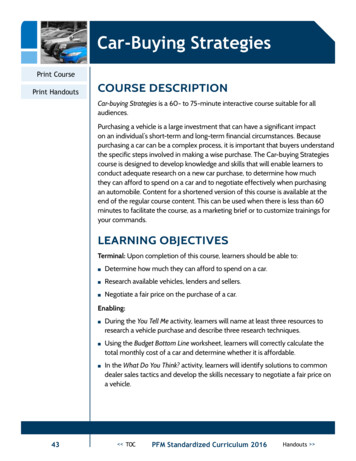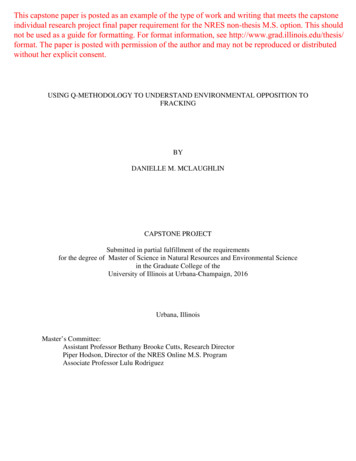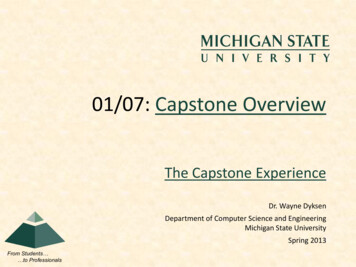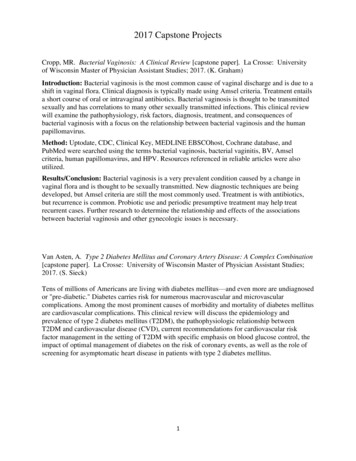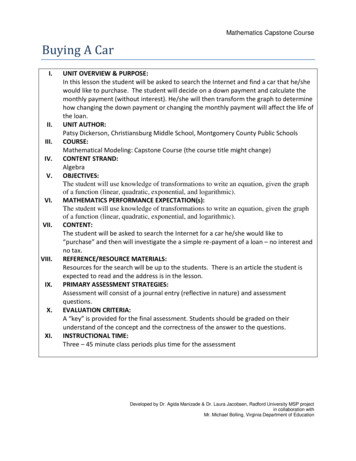
Transcription
Mathematics Capstone CourseBuying A CarI.II.III.IV.V.VI.VII.VIII.IX.X.XI.UNIT OVERVIEW & PURPOSE:In this lesson the student will be asked to search the Internet and find a car that he/shewould like to purchase. The student will decide on a down payment and calculate themonthly payment (without interest). He/she will then transform the graph to determinehow changing the down payment or changing the monthly payment will affect the life ofthe loan.UNIT AUTHOR:Patsy Dickerson, Christiansburg Middle School, Montgomery County Public SchoolsCOURSE:Mathematical Modeling: Capstone Course (the course title might change)CONTENT STRAND:AlgebraOBJECTIVES:The student will use knowledge of transformations to write an equation, given the graphof a function (linear, quadratic, exponential, and logarithmic).MATHEMATICS PERFORMANCE EXPECTATION(s):The student will use knowledge of transformations to write an equation, given the graphof a function (linear, quadratic, exponential, and logarithmic).CONTENT:The student will be asked to search the Internet for a car he/she would like to“purchase” and then will investigate the a simple re-payment of a loan – no interest andno tax.REFERENCE/RESOURCE MATERIALS:Resources for the search will be up to the students. There is an article the student isexpected to read and the address is in the lesson.PRIMARY ASSESSMENT STRATEGIES:Assessment will consist of a journal entry (reflective in nature) and assessmentquestions.EVALUATION CRITERIA:A “key” is provided for the final assessment. Students should be graded on theirunderstand of the concept and the correctness of the answer to the questions.INSTRUCTIONAL TIME:Three – 45 minute class periods plus time for the assessmentDeveloped by Dr. Agida Manizade & Dr. Laura Jacobsen, Radford University MSP projectin collaboration withMr. Michael Bolling, Virginia Department of Education
Lesson 1 Buying A CarStrandAlgebra and FunctionsMathematical Objective(s)The goal of this lesson is to payback the purchase of a vehicle. Students will be asked tocompare simple payback structures of various down payments and monthly payments on therepayment of the cost of the vehicle. The student will make one calculation using downpayment as the y-intercept and the monthly payment as the constant (or slope). The time willbe the independent variable.Mathematics Performance Expectation(s)The student will use knowledge of transformations to write an equation, given the graph of afunction (linear, quadratic, exponential, and logarithmic).Related SOLA.7The student will investigate and analyze function (linear and quadratic) families and theirb)c)d)e)f)domain and range;zeros of a function;x- and y-intercepts;finding the values of a function for elements in its domain; andmaking connections between and among multiple representations of functions includingconcrete, verbal, numeric, graphic, and algebraic.AII.6The student will recognize the general shape of function (absolute value, square root, cuberoot, rational, polynomial, exponential, and logarithmic) families and will convert betweengraphic and symbolic forms of functions. A transformational approach to graphing will beemployed. Graphing calculators will be used as a tool to investigate the shapes and behaviorsof these functions.AFDA.2The student will use knowledge of transformations to write an equation, given the graph of afunction (linear, quadratic, exponential, and logarithmic).AFDA.3The student will collect data and generate an equation for the curve (linear, quadratic,exponential, and logarithmic) of best fit to model real-world problems or applications.Students will use the best fit equation to interpolate function values, make decisions, andjustify conclusions with algebraic and/or graphical models.NCTM Standards2Developed by Dr. Agida Manizade & Dr. Laura Jacobsen, Radford University MSP projectin collaboration withMr. Michael Bolling, Virginia Department of Education
use graphs to analyze the nature of changes in quantities in linear relationships.represent, analyze, and generalize a variety of patterns with tables, graphs, words, and,when possible, symbolic rules;Additional Objectives for Student Learning (include if relevant; may not be math-related):Concepts of borrowing money (banking) and planning with a budgetMaterials/Resources Classroom set of graphing calculators Internet accessAssumption of Prior Knowledge Be able to graph a linear equation with understanding of the range and domain Understand the difference between slope and y-intercept Be able to search the internet to find the price and description of a vehicleIntroduction: Setting Up the Mathematical TaskAll students are interested in buying his/her own vehicle. In this investigation, the student willbe asked to select a vehicle to buy - it can be an antique car or truck, a motorcycle, a used caror truck, or a new car or truck. Of course after the student decided on a vehicle, he or she willneed to pay for the vehicle. The assumption will be made that the student will need to borrowmoney to pay for the vehicle. The student will be able to select a down payment, calculate themonthly payment, and graph the payback. After the graph is established, students will beasked to change the down payment (the y-intercept) or the monthly payment (the slope) andtransform the payment line. The intent of this activity is for the student to see the effect ofhigher or lower down payment or monthly payment and how timely a car loan can be repaid.Student Exploration 1:1. Read the article that discusses the top five mistakes when buying a car. (Individual or groupactivity)2. Student will search the Internet for a vehicle that he/she would like to purchase.3. For this activity, there will be no fees to title the car and no tax. Keep in mind that thesefees do exist and cannot be ignored.4. Student will need to decide on his/her down payment. It must be between 2% and 15%of the total price.5. All students will then find the monthly payment by taking the balance and finding theequal monthly payment for 48 months.3Developed by Dr. Agida Manizade & Dr. Laura Jacobsen, Radford University MSP projectin collaboration withMr. Michael Bolling, Virginia Department of Education
6. Answer the questions on the payment calculation sheet “Just the Facts”. The graphingmay be done on a calculator and sketched on a graph on the calculation sheet.Individual Work - See “Just the Facts” This can be filled out on line or on paper.Whole Class Sharing/DiscussionAfter Sections C – E:1. Allow time for the students to describe the vehicle that he/she has chosen to purchaseand why was that particular vehicle selected.2. Use the questions on “Just the FACTS” to guide discussion.After Section F1. What does the slope represent and what happens to the problem if the slope changes?2. Can the slope be positive the way the problem has been presented?3. How would the problem need to be presented for the slope to be positive?4. Does the graph make sense in all 4 quadrants, why or why not?5. What does the y-intercept and the x-intercept represent in this problem?6. What does the domain represent in this problem?7. What does the range represent in context of this problem?8. Why were the dimensions of the window chosen as they were?9. What has happened if the graph is translated 2 units down?10. Would it mean if the graph were rotated counterclockwise around the y-intercept?Student/Teacher Actions: Before the lesson, the teacher will need to copy the necessary worksheets or prepare thequestions to be answered in a word document to be saved. The student should be finding information and use it to answer the questions and graph theresults The teacher should be walking around the room, talking with the student and answeringquestions.Monitoring Student Responses4Developed by Dr. Agida Manizade & Dr. Laura Jacobsen, Radford University MSP projectin collaboration withMr. Michael Bolling, Virginia Department of Education
ooooostudents are to communicate their thinking and their new knowledge of slope andy-intercept when paying back a loan;students are to communicate how the graph would change if the slope or the yintercept were changes;teacher and/or students are to highlight and clarify the relationship of translationand y-intercept and of rotation and slope;teacher should be a presence as the students are doing the investigationSummarize the lesson: The discussion of the questions will be the summary of the lesson.Assessment Describe and attach the assessments for each lesson objective.o Written Assessment: Attached – “Buying A Car Quiz”o Journal/writing prompts – to be written on the board and answered after theinvestigation Write what you believe to be the best way to finance the purchase of thevehicle you selected. Explain why. Think about what type of job you wouldneed to have to make the payments you have outlined. How has this activity made you think about the purchase of a vehicle?Extensions and Connections (for all students)o Students can purchase a really expensive vehicle (i.e. F350 diesel engine, stretch cab2011 Ford truck or a brand new Jaguar) and make a presentation to the class withgraphs to explain the “best way” to finance this purchaseo Students can included tax and other fees collected at the time of purchase to seehow that might affect the graphing of the situation (This can be done in an Excelspreadsheet)o Students can change the monthly payments pay from 48 months to 36 months or 60months or 72 months and explain how that would change the graph.Strategies for Differentiation List ideas for addressing needs of a diverse population of students such as:o kinesthetic, auditory, or visual learners – This activity addresses many of these typesof learner. The students will need to search for a vehicle of his/her desire. Givingthe Web-sites where this can be done might be helpful.o The directions should be given out loud as well as written. An example might needto be provided for some. ;o Students with processing, memory, motor issues – If a student has motor issues thatdoesn’t allow his/her to type, they might be partnered with someone with similarvehicle interests.;5Developed by Dr. Agida Manizade & Dr. Laura Jacobsen, Radford University MSP projectin collaboration withMr. Michael Bolling, Virginia Department of Education
o English language learners (ELLs) – These students may be partnered with anotherstudent who can help him/her understand the process. The lesson also may betranslated into Spanish or other languages.;o high-ability students - Students can change the monthly payments pay from 48months to 36 months or 60 months or 72 months and explain how that wouldchange the graph.6Developed by Dr. Agida Manizade & Dr. Laura Jacobsen, Radford University MSP projectin collaboration withMr. Michael Bolling, Virginia Department of Education
Buying a CarA. Challenge:Select a car to purchase. Payment for the car will be made through adown payment and monthly payments. Analysis will be made based on changing the graphsby translating based on knowledge of slope and y-intercept.B. Materials Needed:Graphing calculator, Internet accessC. Background Information: Use the Internet to describe the following terms:1. Down payment2. Monthly payment3. Life of the loan4. y-intercept5. Slope7Developed by Dr. Agida Manizade & Dr. Laura Jacobsen, Radford University MSP projectin collaboration withMr. Michael Bolling, Virginia Department of Education
D. Read the article “Top Five Biggest Mistakes When Buying aCar”. List a briefly describe in your own words the 5 biggestmistakes consumers make when buying a a/newcarmistakes.htm1.2.3.4.5.8Developed by Dr. Agida Manizade & Dr. Laura Jacobsen, Radford University MSP projectin collaboration withMr. Michael Bolling, Virginia Department of Education
T or F based on the article:1. It is “smart” to buy a car for 0 down.2. When considering a vehicle, the cost of the car is the only financial consideration.3. A new car is a wiser investment financially that a 2 year old car.Discuss the answers to these questions with a partner or the class beforeproceeding to purchase your vehicle.E. Search the Internet for the car you will purchase. Keep inmind you should be reasonable with your desires. You can “dream”later on in the activity.Describe in detail your vehicle and cost. COST:9Developed by Dr. Agida Manizade & Dr. Laura Jacobsen, Radford University MSP projectin collaboration withMr. Michael Bolling, Virginia Department of Education
F. “Just the Facts”- Write a journal entry when this data iscompleted.1. Cost of vehicle:2. Down Payment: (between 2% and 15% of the cost)3. Balance Borrowed (#1. - #2)4. Monthly Payment (#3 48 months)Complete a table of the payments: # of months Balance Owed(Balance Borrowed - # of months *monthly payment)Example:0Cost of car - 10,0001Down Payment - 10002Balance Owed - 90003Monthly Payment - 187.504For 0 months:209000 – 0* 187.50 90004045For 1 month:469000 – 1*187.50 8812.50474810Developed by Dr. Agida Manizade & Dr. Laura Jacobsen, Radford University MSP projectin collaboration withMr. Michael Bolling, Virginia Department of Education
Graph the data from the chart on the previous page. Label the axesand choose an appropriate scale for each axis (example: each square onthe x-axis represents two months)1. Describe the shape of the graph (say more than it is a straight line)11Developed by Dr. Agida Manizade & Dr. Laura Jacobsen, Radford University MSP projectin collaboration withMr. Michael Bolling, Virginia Department of Education
2. If time in months is the independent variable, what is thedependent variable in the model?3. Write an equation (in the slope-intercept form or in functionnotation y mx b) to represent the situation of buying a car asdescribed in this problem. (Hint: Look at the graph or table todetermine the slope and y-intercept)4. What does the y-intercept represent?5.What is the slope in the context of this problem?6. Is the slope positive or negative? Explain in the context of thisproblem. ( Remember slope y 2 y1)x 2 x1 12Developed by Dr. Agida Manizade & Dr. Laura Jacobsen, Radford University MSP projectin collaboration withMr. Michael Bolling, Virginia Department of Education
7. Graph the equation written in #3 on your calculator. Adjust thewindow so the graph (including the x and y intercept) is visible. Thescale for the x and y axis will be different so the graph can be viewed.Give the dimensions of the window view:x- maximumy-maximumx – minimumy- minimumx - scaley – scaleSketches of the graphs should be included when appropriate whenanswering the questions.8. What does the x-intercept represent in the context of thisproblem?9. If the graph is translated 3 units up, is the monthly payment or thedown payment being changed? How does that change the graph andhow does that change the outcome of this problem? Graph the newgraph with the original graph in your calculaator. Describe whathappens to the graph. What type of transformation is thisWhat is the new equation for this new line (translated 3 units up)?13Developed by Dr. Agida Manizade & Dr. Laura Jacobsen, Radford University MSP projectin collaboration withMr. Michael Bolling, Virginia Department of Education
10. Sketch the graph as it nowappears on your calculator:11. If the slope on the original graph is doubled, what happened to themonthly payment and/or the down payment? What type oftransformation will represent this change?Write the equation for this new graph. What stays the same and whatchanges from the original equation?What is the affect on the outcome of the life of the loan?11. If the slope of the original graph is cut by 25%, does the monthlypayment or the down payment change?Transformation type?What is the affect on the outcome of the life of the loan?(Write the journal entry on the board when this data is complete.)14Developed by Dr. Agida Manizade & Dr. Laura Jacobsen, Radford University MSP projectin collaboration withMr. Michael Bolling, Virginia Department of Education
ASSESSMENT: “Buying A Car”You are going to buy a 1999 Ford Mustang GT for 4500. You canafford to make a down payment of 250. You will be making 24payments to pay for this car. Answer the following questions based onyour work on “Buying A Car”.1. List 3 of the 5 biggest mistakes consumers make when purchasing acar:a.b.c.2. What will be the monthly payment for this purchase?(Hint: Use the down payment and repay the amount borrowed over 48months.)3. Write an equation in the slope-intercept form to represent thissituation.4. a) If you can afford to pay 250 down payment and 250 a month,how long will it take the loan to be completely paid for?15Developed by Dr. Agida Manizade & Dr. Laura Jacobsen, Radford University MSP projectin collaboration withMr. Michael Bolling, Virginia Department of Education
b) What is the new equation in slope-intercept form?5. If your down payment can be 750, how many months will it takeyou to pay the loan if you pay the same monthly payment calculated in#2?6. What does the slope represent in the formula you used?7. What does the y-intercept represent in the formula you used?8. If the original graph is translated down, what has happened incontext of the problem? How does the equation change?9. If the original graph is rotated around the y-intercept, what hashappened in context of the problem?10. What would happen to your graph if tax and fees to title thevehicle were included? Write an equation for this and explain what allof the numbers and variables mean. Assume tax (3%) and fees (1.5%)are paid at one time with the down payment.16Developed by Dr. Agida Manizade & Dr. Laura Jacobsen, Radford University MSP projectin collaboration withMr. Michael Bolling, Virginia Department of Education
ASSESSMENT: “Buying A Car”- KEYYou are going to buy a 1999 Ford Mustang GT for 4500. You canafford to make a down payment of 250. You will be making 24payments to pay for this car. Answer the following questions based onyour work on “Buying A Car”.1. List 3 of the 5 biggest mistakes consumers make when purchasing acar: (These can be listed from the article.)a.b.c.2. What will be the monthly payment for this purchase? (4500 –250)/24 177.083. Write an equation in the slope-intercept form to represent thissituation.y 4250 – 177.08x -177.50x 4250b amount borrowedx number of months4. a) If you can afford to pay 250 down payment and 250 a month,how long will it take the loan to be completely paid for?0 4250 – 250xx 17 months17Developed by Dr. Agida Manizade & Dr. Laura Jacobsen, Radford University MSP projectin collaboration withMr. Michael Bolling, Virginia Department of Education
b) What is the new equation in slope-intercept form?Y 4250 – 250x -250x 42505. If your down payment can be 750, how many months will it takeyou to pay the loan if you pay the monthly payment calculated in #2?0 3750 – 177.08xx 21.17months which would mean 22 months but the last payment would not bea full 177.086. What does the slope represent in the formula you used? Monthlypayment7. What does the y-intercept represent in the formula you used?Amount of money borrowed after the down payment8. If the original graph is translated down, what has happened incontext of the problem? How does the equation change? The downpayment has increased because the y- intercept (amount owed) is less.The equation would have the same slope but a smaller y-interceptdepending on the down payment.9. If the original graph is rotated around the y-intercept, what hashappened in context of the problem? The monthly payment haschanged. It has increased or decreased depending on the direction ofthe rotation or slope.10. What would happen to your graph if tax and fees to title thevehicle were included? The amount owed (y-intercept) would change.The slope would also change because the initial amount borrowed wouldbe more.18Developed by Dr. Agida Manizade & Dr. Laura Jacobsen, Radford University MSP projectin collaboration withMr. Michael Bolling, Virginia Department of Education
19Developed by Dr. Agida Manizade & Dr. Laura Jacobsen, Radford University MSP projectin collaboration withMr. Michael Bolling, Virginia Department of Education
All students are interested in buying his/her own vehicle. In this investigation, the student will be asked to select a vehicle to buy - it can be an antique car or truck, a motorcycle, a used car or truck, or a new car or truck. Of course after the student decided on a vehicle, he or she will need to pay for the vehicle.

